Why should one be hesitant, after writing of Swedish immigrant churches in a dozen places, to take on the subject of the old home town? Perhaps because the subject is "too close to home". One senses a "cloud of witnesses" looking over one's shoulder...to see that matters are properly represented. On the one hand we have a variety of new insights which can only come from outside observers in the form of conference historians and others, and on the other hand we have our native memories and stories instilled from youth. Even in our small world, myth and history collide. As so often has happened, something appears which removes the barriers and progress is possible. This event is worth recounting.
Our friend and fellow "Swedish churchfinder", Chuck Leypoldt, unearthed a set of scrapbooks kept long ago by a Wausa pioneer family, the Engdahls. One of them was devoted to a series of history columns by the local editor, C.A. Anderson. Now, the Anderson family was already familiar to our stories from their Saunders county origins, but we were about to learn much more. (We even discovered that a premier history book on the Swedish Augustana Synod was written by a son of this family. The connection was obscured since he had changed his name from Anderson to Arden.) His uncle who edited the historical columns was deeply involved in the Wausa church stories, and we are unbelievably fortunate to have his account in hand.
So we are able to provide information in depth and breadth beyond our own perspective, and the complete series is attached. C.A. Anderson columns
We will include excerpts from time to time in the pages to follow. Those who are interested in the Wausa churches are in for a treat.
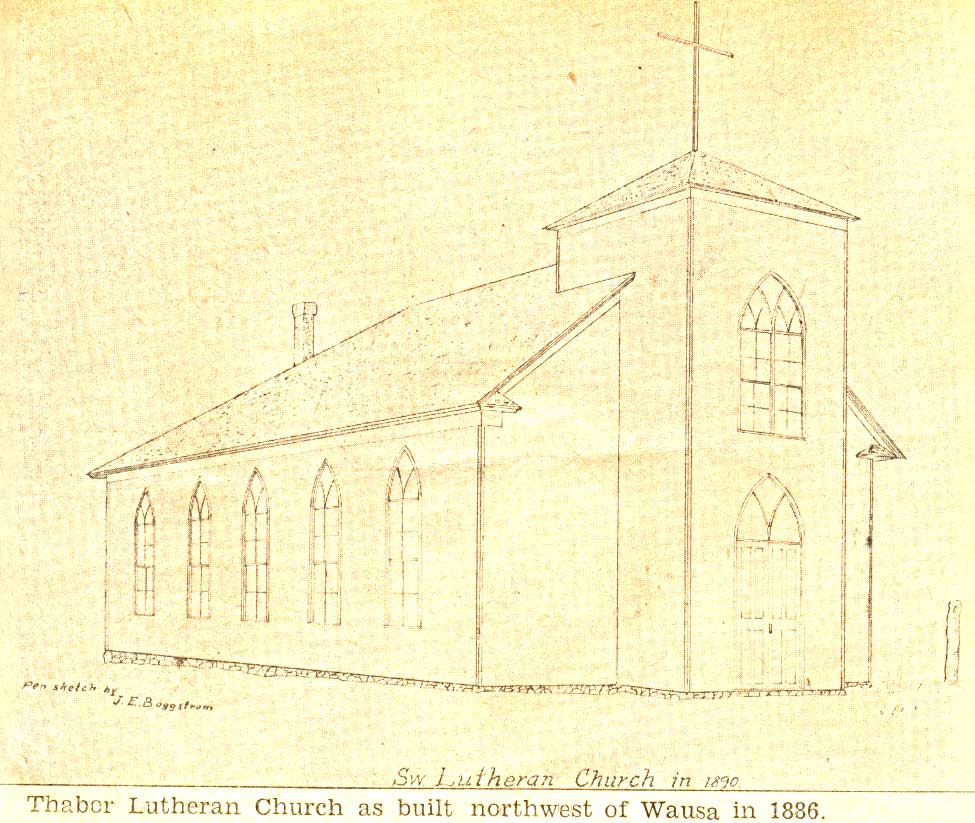
Editor Anderson may have no pictures of the first country building,
he offers this drawing by member Baggstrom
We mentioned "conference historians", and to us that means primarily the man we call the "Dean of Nebraska Swedish church historians", C.F. Sandahl. His intimate knowledge and candor can produce in a few pages some striking new insights; things that we had never heard of before. His section on the Thabor congregation, written in 1931, begins: "Thabor, Wausa, is now the largest congregation in the Nebraska Conference." Bigger than any of the Omaha Augustana churches, bigger than Oakland where Sandahl served as pastor, and bigger than his home parish, Calvary Swede Home in Polk county, though these were the closest rivals in terms of size. "Nearly seven hundred communicant members" are reckoned.
Wausa, one of the last of the Swedish immigrant colonies in the state, had moved to primacy; "the last shall be first." But...how do you pronounce the name Thabor?? Anyone with Swedish ancestry knows that the immigrants did not have the "th" sound in their speech inventory. "Dat's von ting dey did not haf." But look up the references to Mount Tabor in your Bible and you will find no "th" there either. We have two family Bibles in Swedish: the later of the two has "Tabor", but the earlier, in old Germanic script and thus almost unreadable, has "Thabor." This must be the origin of the "Thabor Lutheran" spelling , though the "th" sound which is sometimes heard today would have sounded strange indeed to the Swedes.
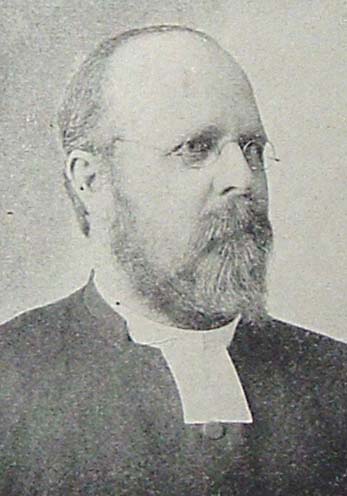
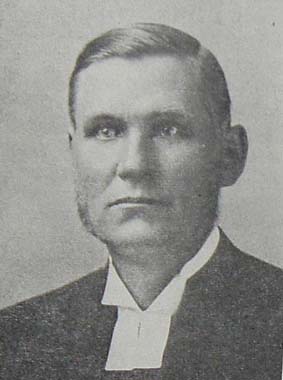
Augustana Pastors Fogelstrom and Torell
Back to Sandahl. A second-generation land developer by name of Thomas Thorson had identified the southeast corner of Knox county as a good prospect for promotion among his Swedish countrymen. The "Gillman Land Company" held much of the land in the area according to early maps, others report that the Quimby and Crum agency of Creighton authorized Thorson to act as their agent. Following a pattern seen across the midwest, enterprising land agents enlisted the help of immigrant clergy in directing and promoting their people to form colonies. Usually, free church sites went along with the deal and perhaps more.
So, Thorson contacts Reverends Fogelstrom and Torell with this very scheme in mind. The former "wrote articles in the Swedish press about the great opportunities for a Swedish settlement..." The latter "made arrangements with it " (the land company) "to sell land to none but Swedes for a certain period of time and at a fixed price. In this way Swedes began to move in from other parts, so that a Lutheran congregation could be organized." This was soon accomplished, and the land value promptly doubled and quadrupled at Wausa, making the whole venture most favorable for all concerned. Fogelstrom and another Augustana pastor, F.N. Swanberg, each bought quarter sections and Torell bought a half section.
We do not wish to dispel the noble myths of daring pioneers blazing trails through the wilderness to that special spot of ground upon which the shaft of sunlight falls, beckoning them to settle in this or that place to which providence has guided them. But marketing, advertising, calculation and speculation are nothing new. Neither is "church planting."
We include here more information about Thorson from C.A. Anderson's columns. (For a sampling of Wausa's broader history from the "Gazette", click here. General Wausa stories)
Thorson's son writes to the Gazette: "My father and mother were raised around St. Peter, MN, born of pioneer families... In Nebraska they built a sod house and lived in this possibly two or three years, when they built a small house. One daughter, Theodora, was born in the sod house in 1884... I was born in in the new frame house in 1887. My father had the post office in his home...named Thorson... We moved...in about 1895 to Alabama. There he founded a town known as Thorsby..."
(note: the son is modest about his family; Thorsons had been a land agents at St. Peter, responsible for the location of Augustana's Gustavus Adolphus College there and served in the same way at Wausa and in Alabama, the $7,000 with which he left was not only the result of sheep raising as his son suggests)
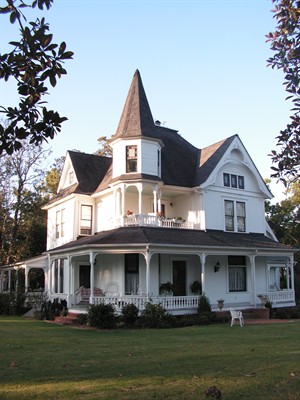
In the Swede Bend section we show land agent Jeaneson's home.
Thorson's is equally grand, now resored in Thorsby, Alabama
Some background on Thorson's coming to the area: "Rev. E.A. Fogelstrom, founder of Immanuel Hospital and Deaconess Institute at Omaha, had asked Mr. Thorson to advise him if, in his wanderings, he should find a good location for a Swedish colony, where good land could be had at low price. Mr. Thorson wrote Rev. Fogelstrom that here was Paradise Valley. Late that summer (1883) Rev. Fogelstrom and Rev. John Torell, of Oakland, drove up to investigate the location... The reverend gentlemen were highly pleased with the location and forthwith made arrangements to establish a colony here. They made agreements with Messrs. Quimby & Crum, land agents at Creighton for terms under which the land in this area should be sold. Mr. Thorson was appointed local agent and locator."
(note: the cooperation of ministers and land agents is a common theme of the immigration; historian C.F. Sandahl records that the area was advertised among Swedish Lutherans and that the "reverends" ended up with a farm each as later plat books confirm)
"...Mr. Thorson and some others got busy and had an overland mail route established between Creighton and Hartington. A post office was established in Mr. Fletcher's home, which he named 'Orient', saying that he lived at the east end of the world, in the Orient. From there the route angled across the prairie, following closely the old Gordon and Black Hills trail to Hartington"
(note: below we include a map of that trail which goes very close to Aunt Leona Gustafson's and just north of our old place, across the Rosberg farm; Orient is located along the Creighton road we are familiar with and west of our place...maybe about where Midland store was)
These insights have been a lesson to me in how one may be born and grow to adulthood in a community while remaining completely oblivious to many interesting facts about its history.
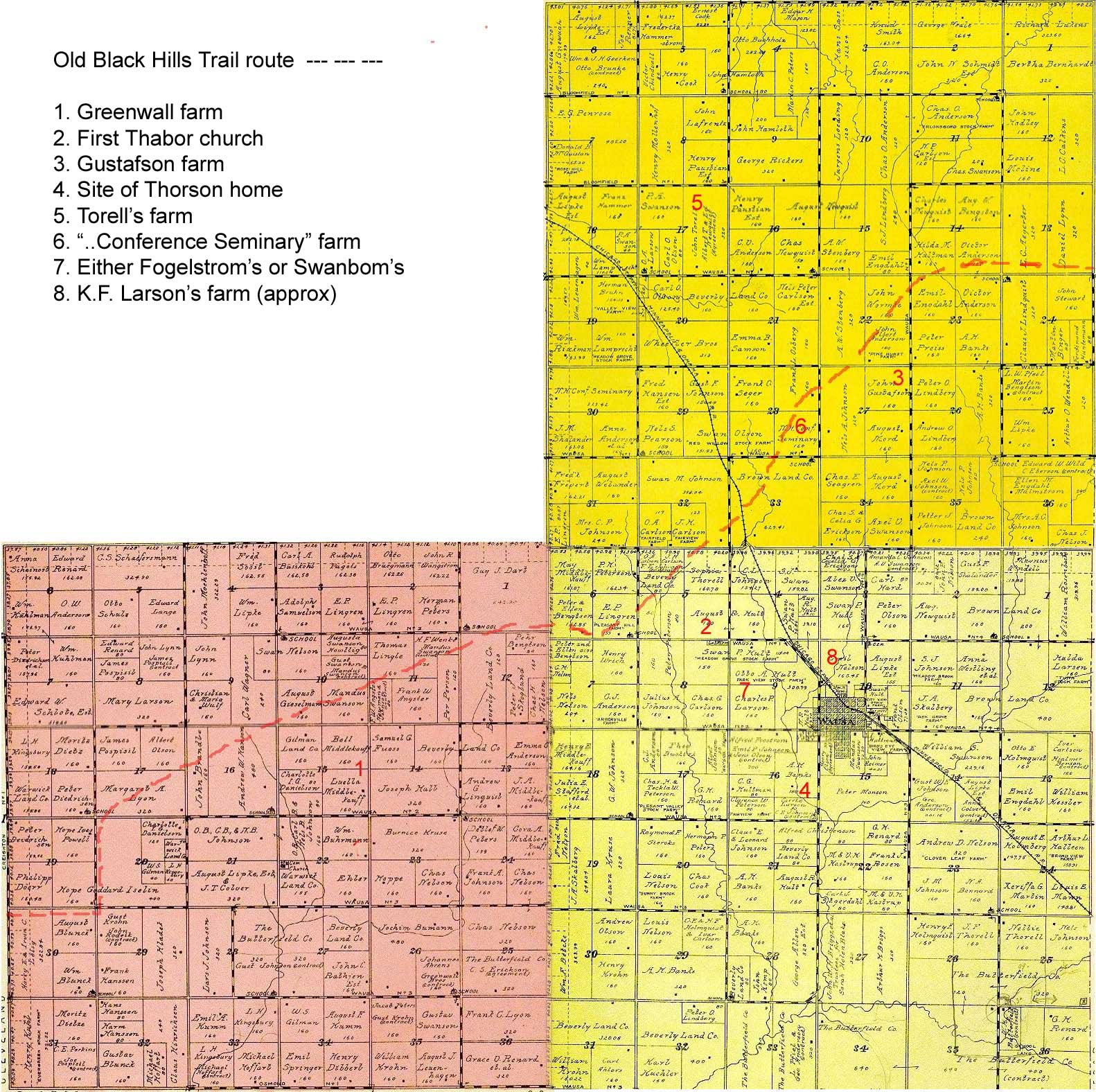
Thorson now makes good on his pledge to the "reverends" and a congregation is organized July 20, 1885, in the N.P. Hult home with 21 charter members. The first services are held in the Thorson "new frame house." The pastor from Wakefield makes visits to shepherd the congregation in its infancy. Other pastors from the Omaha district also visit, no doubt both to encourage the new congregation and inspect their purchases.
Immediately the question of building a church building was discussed, but as the settlers were all in meager circumstances there were those who argued that this could not be accomplished. Mr. Bard was one of the more aggressive and it is credited to him to have replied at one time that "a church building we must have, even if I have to donate a forty acre piece of land". Then, as always, there must be these who dare and do. Thus, in the following year, 1886, a decision was reached to proceed to build a church building and the size decided upon was 50 x 32 ft., which proves that these early comers had hopes of the future of the community and would need a large house of worship then to accommodate those twenty-one charter members. Building of the church was started that year, but due to financial hardships the interior of the building could not be completed. Nor was is ever fully completed upon the site where first erected being on the north side of the road past the present Lutheran cemetery northwest of Wausa.
As is so often the case, the cemetery becomes the permanent marker and this Lutheran cemetery remains in this place to this day. Also it is noteworthy that among these charter members are forebears of the writer's relatives. The Hult in whose home the congregation was organized is also a forebear of relatives, but his name does not appear on the charter list. More on that later.
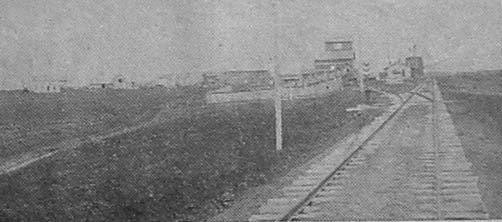
Poor quality but revealing: Wausa 1891 from the east down the new tracks:
"house of Mrs. Newman to the left", hotel, elevator, depot, water tower, stockyards in foreground
And also as so often is the case, the coming of the railroad will impact the Thorson community. It is virtually in sight of the new Lutheran church, but the developers of the townsite offer a free lot to the "first congregation" to locate within the city limits. This incentive may not have stirred the Thaborites, but their Lutheran pastor-leaders knew from bitter experience that to ignore the railroad's influence would be a mistake. In Phelps county the railroad bypassed old Bethany church, and because it would not move to the railstation of Axtell, there were ultimately somewhat competitive congregations located there and elsewhere along the Burlington. In Polk county the Swede Home church was bypassed by the Stromsburg branch of the Union Pacific and similarly lost momentum. They were not about to be fooled again. C.A. Anderson has the details:
At the annual meeting of the Thabor Lutheran Church held January 2nd, 1891, a resolution was adopted that a location for the church and a parsonage should be selected In the town of Wausa, and a committee to attend to this was chosen. The present location was selected, it was in the "First Addition to Wausa", and there was not a building in the whole "Addition". At a special meeting held October 7, it was decided to move the church to town as soon as possible, it was moved that winter, a, Mr. Frezell doing the job for $235... At a business meeting held on the 7th of October 1891, it was decided that as the church building was moved to the village of Wausa it should be placed on lots 4 and 5, block 20. It was further decided at this meeting that the parsonage be built on lots across the street which were being negotiated for. Committee selected to have charge of the moving of the church building was C. A. Swanson, C. P. Bloomquist, Gustaf Swanson, Nils Johnson and Rev. Aurelius.
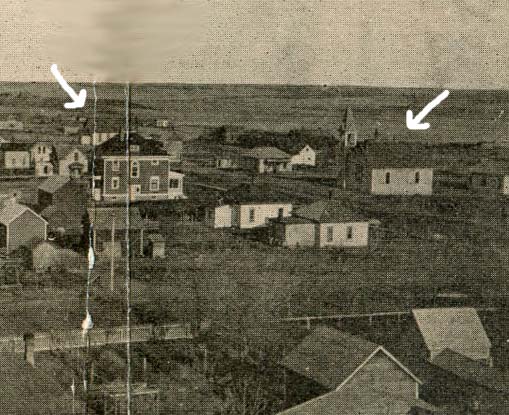
In this 1904 view from Thabor steeple, the Methodist church is visible on the right
and beyond it the Mission church
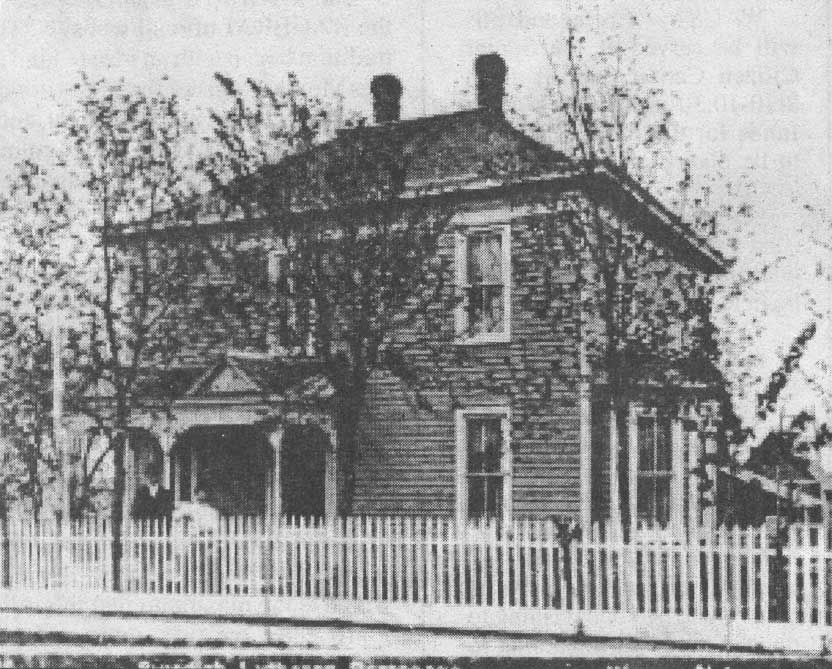
Marilyn Greenwall Hult supplied this picture with Ethel Lindgren's account
of the parsonage to a recent Gazette story
We might here insert a short part of a letter from Rev. Aurelius written at the time of the fortieth anniversary of Thabor.
" During the fall of 1891 the student A. J. Borgstrom was called by the Mission Board of the Conference to assist in my work in Wakefield and Concord in order that I might be able to give all my time to Wausa. My plans were: (1.) To have our church building moved, into town. (2.) To have a parsonage built in Wausa. (3.) To have the congregation call a local pastor. The Townsite Company of Wausa had made very liberal offers to the 'first congregation that was ready to build a church in town and also to the first parsonage built in Wausa.' Later an offer was also made for the first English church built in town. At this time there was only one English speaking family located in town. So I promised the Company that we would make an effort to call a minister capable to preach the word in both languages so that a Sunday evening service could be held occasionally in the English language. The Townsite Company accepted these prospects, requested us to move the church building at once and erect a suitable parsonage to be finished in the summer of 1892. The Company would give us all the necessary lots for the buildings. I expected this would be good news to the congregation but to my surprise some of the leading members, who had contributed the largest subscriptions, protested, stating that the church out in the country should never be moved in to town.
They started a propaganda against moving the church. I called an extra meeting of the congregation. With an overwhelming majority it was decided to move the church to Wausa. The undersigned with two others were selected as a committee to carry out said motion. We started the following day to make contract with a house mover in Wayne. On Monday the following week, the church was on its way to town. The sheriff from Niobrara arrived on the scene and ordered the church building back on its former foundation, but when he heard we had legal right according to our church constitution, to move the church to Wausa, he exclaimed "Alright, gentlemen, proceed in your work. God bless you!" We now started on our soliciting trips for building fund...
We have here the details on good authority; mercifully the losers in this contest remain anonymous though somewhere among the dusty memories of Thaborites the names of the notorious protesters are surely preserved....we are Swedes, after all.
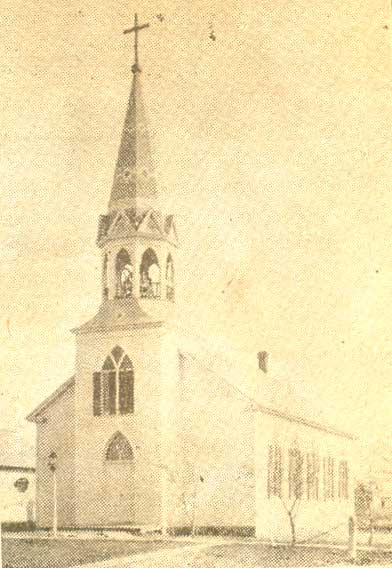
Now safely in town, Thabor had added a steeple and bell by 1896
The interior of the church was plastered and cased up and a gallery built late in the summer of 1892. Kitchen chairs were used as seats until 1893, when pews were purchased and installed. Rev. C. G. Olson of Elgin, Ill., was tendered a call for the second time by a unanimous vote at a special meeting held July 17, 1891, the salary to be $600 for the first year and free parsonage. After some delay Rev. Olson sent in his acceptance of this call and on Sunday, May first, 1892 he preached his initial sermon as Thabor's first resident pastor. Rev. Olson continued in this charge for more than fourteen years, and his untiring work and influence together with that of his charming and unpretentious wife, a truly Christian soul, left a lasting imprint on the whole community, and to a great extent directed its moral course. Surely no one who came in contact with these people can ever forget them.
Pastor Carl G. Olson
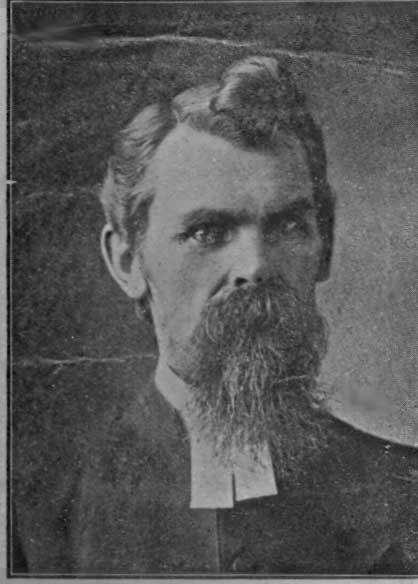
Pastor Olson and Thabor church are now on their way, with Wausa, to prosperity. So quickly does the congregation grow that it has need of larger quarters by 1903; and it is strong enough to accomplish the task and dedicate its impressive new church one year later. This is the church that still stands proudly upon high ground in the village of Wausa more than a century later.
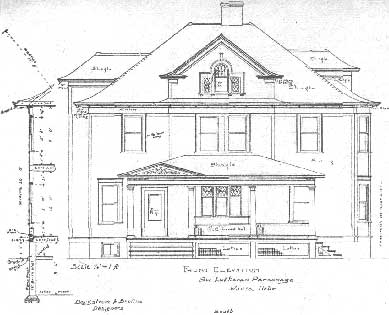
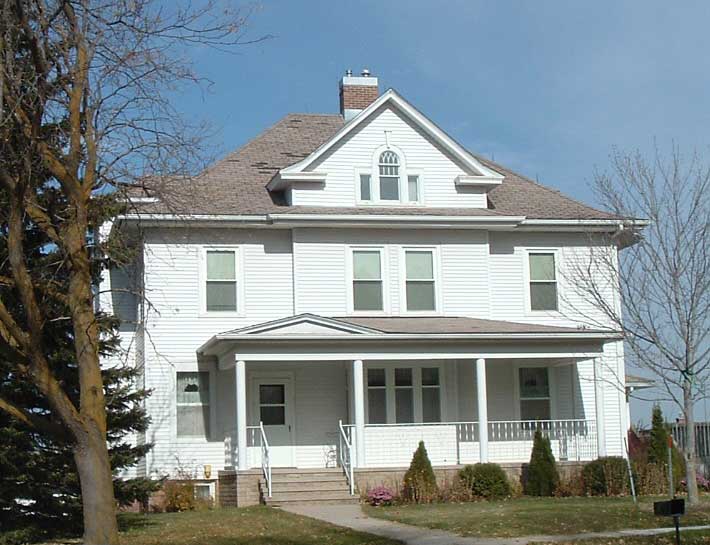
Plans for the impressive Lutheran Parsonage, and its appearance today
At the time Thabor was founded, there was no Nebraska Conference of the Augustana Synod: Nebraska was a mission field entrusted to the Kansas Conference. But Nebraskans were eager for independence and Wausa was able to display its energy by hosting three annual meetings of that state body. In 1893 this meeting was also the occasion of the dedication of the newly relocated church in town; in 1904 it again marked the dedication of the new building; and in 1923 the Conference again convened at Thabor. Little wonder then, that Sandahl says, "Loyalty to the town, community, church, Synod and Conference, even to the extent of boasting a little sometimes, has characterized its people."
We have exhumed some facts about clergy land speculation in this Wausa story, so we are glad now to point out that these gentlemen also acquitted themselves well. The 1920 plat maps of the township reveals that at least one of these farms have been deeded to the Lutheran Academy of Wahoo; the Nebraska Conference's institution of Christian learning!
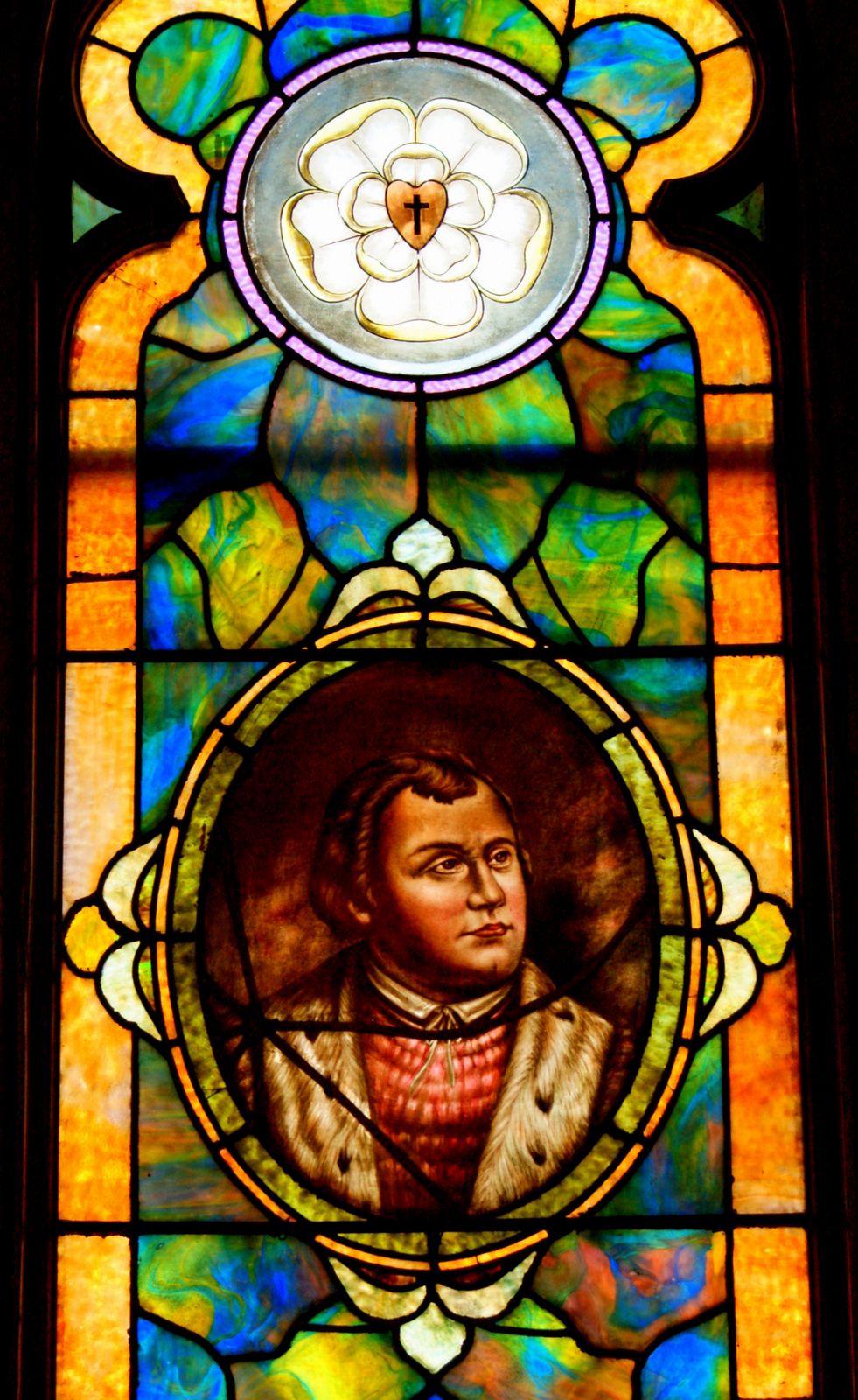
A Thabor window
1889
"The first children inhabitants that Wausa could boast of were Jimmie Teilborg, the one year old son of Mr. and Mrs. Chris Teilborg, proprietor of Wausa's first hotel, and Alfreda Engdahl, now Mrs. O.W. Sjogren, the year and a half old daughter of Mr. and Mrs. Emil Engdahl. The Engdahls moved from the farm into town two days after the Teilborgs moved in. The Sjogren family now live in Huntington Park (part of Los Angeles) California."
(note: our belief that Alfreda is the one who kept the scrapbook containing these clippings is supported in a variety of ways. The Emil Engdahls also went to Los Angeles)
1929
"The local telephone exchange which had been owned and operated by Emil Engdahl, J.E. Baggstrom and Uri Hillman, disposed of their Wausa and Crofton exchanges to the Bell Company."
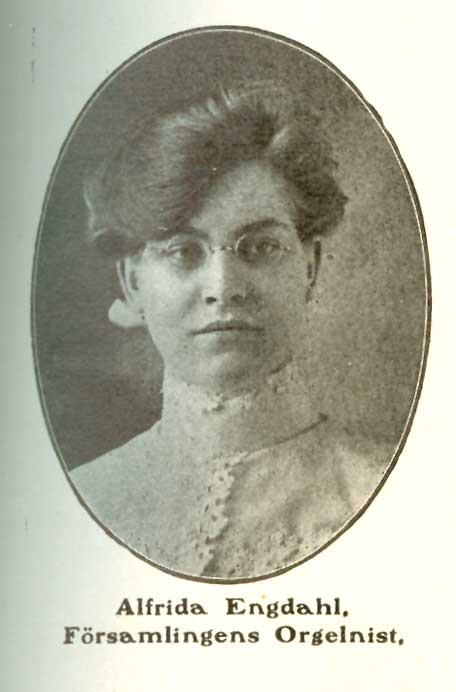
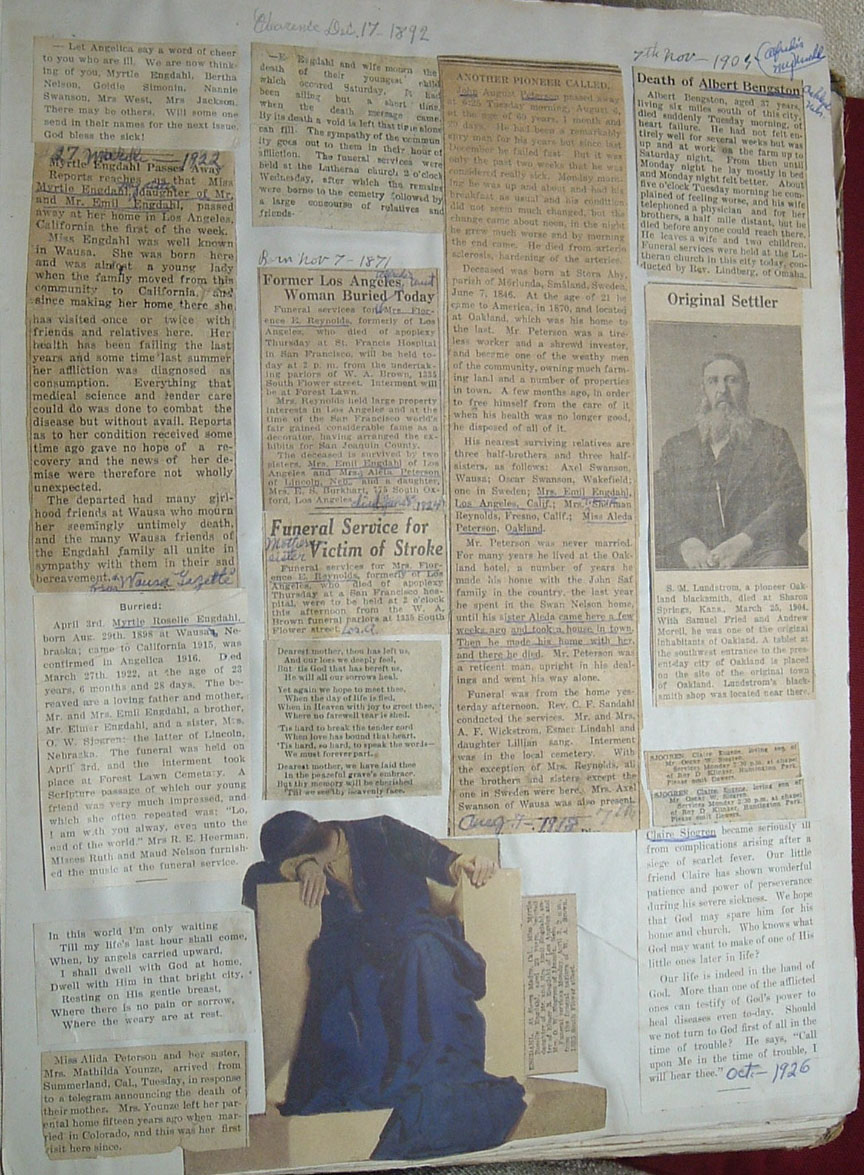
Alfreda Engdahl and a page from her priceless scrapbook
The grieving figure appears beside the death notice for her young son
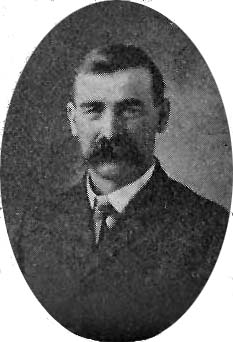
Emil Engdahl
Like Thorson, he did not leave Wausa empty-handed when moving to Los Angeles in 1915. There he served as treasurer of the Lutheran Hospital and helped organize the California Lutheran Hospital Association. His name appears frequently in Thabor history and we surmise his contributions to their early strength was significant. The "Larson-Engdahl Building", so marked on Wausa's main street, was built to house his brother August's implement business partnership. It was later home to the Hultcraft Boat Works and today is home to a collection of antiques and memorabilia.
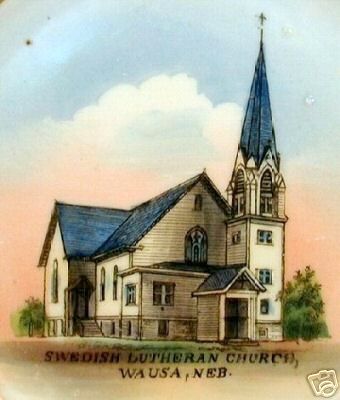
Image from a commemorative plate of Thabor
Historian Sandahl remarks, "In early days this, as well as nearly every other congregation in Nebraska had to go through a fiery test of religious dissention, but through God's grace it came out of it rooted and established in the faith." C.A. Anderson's account has very little evidence of this, and the evolution of the Wausa churches seems to have been largely spared the more painful divisions in other Swedish communities in the previous decades. We have been struck by present day Augustana Foundation historian Mark Granquist's report that, "During the '70's and '80's, synodical records show that Augustana pastors exercised church discipline and excommunication against 1,000-2,000 members per year (on the average), most of whom were supporters of Waldenström." That this strife had passed does not remove the regrets that separation among believers brings to generations yet unborn. A relative of mine who has a more casual connection with Wausa revealed recently her misconception that the towering church on the hill was a Catholic church!
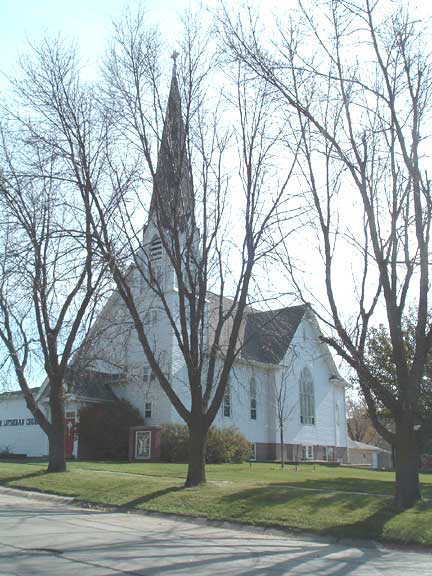
Thabor today (please pronounce it "Tabor")